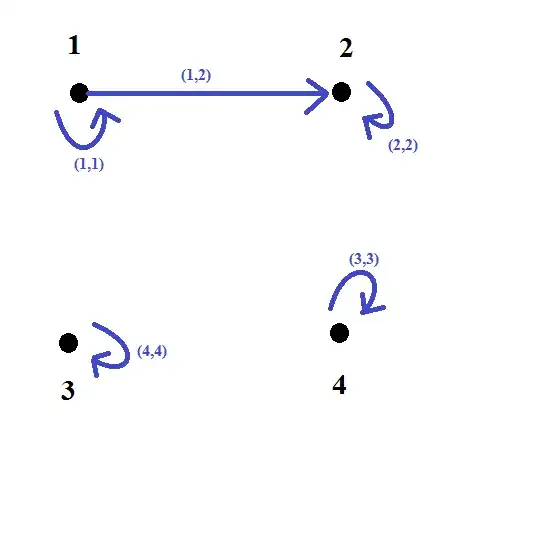Since you have asked other questions about relations (with possibly more to come in the future) I think the following explanation should help you a good deal.
It may be helpful to think in terms of (directed multi-) graphs to visualize relations and their properties.
We construct the graph $G$ for the relation $R$ on the set $A$ in the following way:
- For each element in $A$, draw a vertex and label it.
- For each pair $(a,b)$ with $a\neq b$ in the relation, draw an arrow starting from vertex $a$ and ending at vertex $b$. $\rightarrow$
- In the special event that you have both $(a,b)$ and $(b,a)$ are in the relation, instead of drawing a second arrow, make the arrow from $a$ to $b$ doublesided. $\leftrightarrow$
- For each pair $(a,a)$ in the relation, draw a loop from vertex $a$ ending at vertex $a$.
Your relation:

The usual relation properties we are interested in:
$\begin{array}{|c|l|l|}
\hline
&\text{Set theoretic}&\text{Graph theoretic}\\
\hline
\text{Reflexive}& \forall a\in A, (a,a)\in R&\text{Every vertex has a loop}\\
\hline
\text{Symmetric}& \text{If} (a,b)\in R~\text{then}~(b,a)\in R&\text{All arrows (if any exist) are doublesided}\\
\hline
\text{Anti-symmetric}&\text{If} (a,b)\in R~\text{and}~(b,a)\in R~\text{then}~a=b& \text{All arrows (if any exist) are singlesided}\\
\hline
\text{Transitive}&\text{If} (a,b)\in R~\text{and}~(b,c)\in R~\text{then}~(a,c)\in R& \text{If there exists a directed walk} \\
&&\text{of any length from}~a~\text{to}~b~\text{(a way to travel from}~a~\text{to}~b~\\
&&\text{traveling only in the direction of arrows)}\\
&& \text{then there must be an arrow from}~a~\text{to}~b\\
\hline
\end{array}$
One can show that each pair of definitions above are equivalent.
In your case, we can see from the graph that it is indeed reflexive since every vertex has a loop, it is not symmetric since there exists an arrow which is not doublesided, it is antisymmetric since there does not exist an arrow that is doublesided, and it is transitive since every directed walk possible in the graph has a directed edge that takes you from start to end in one step.
